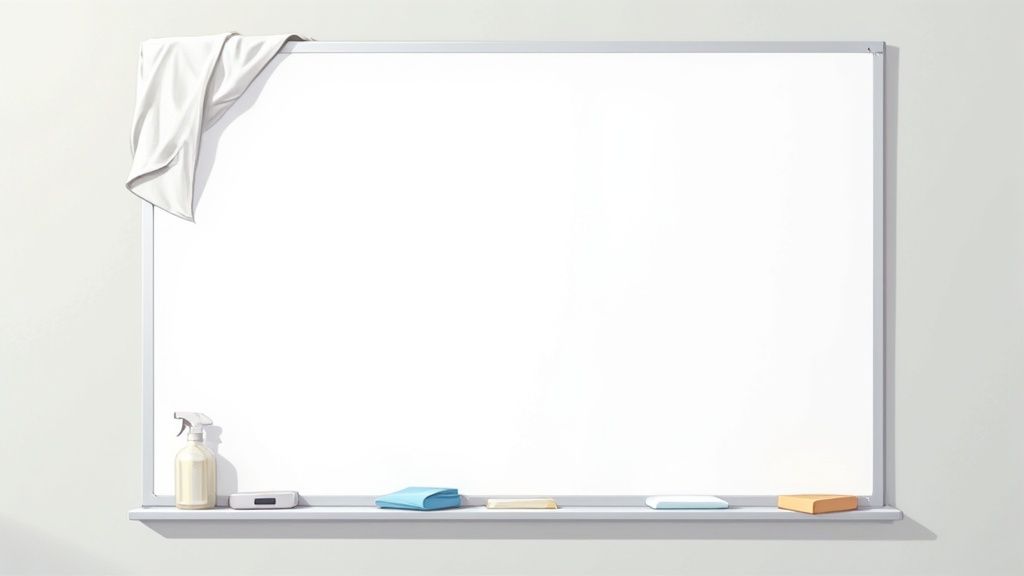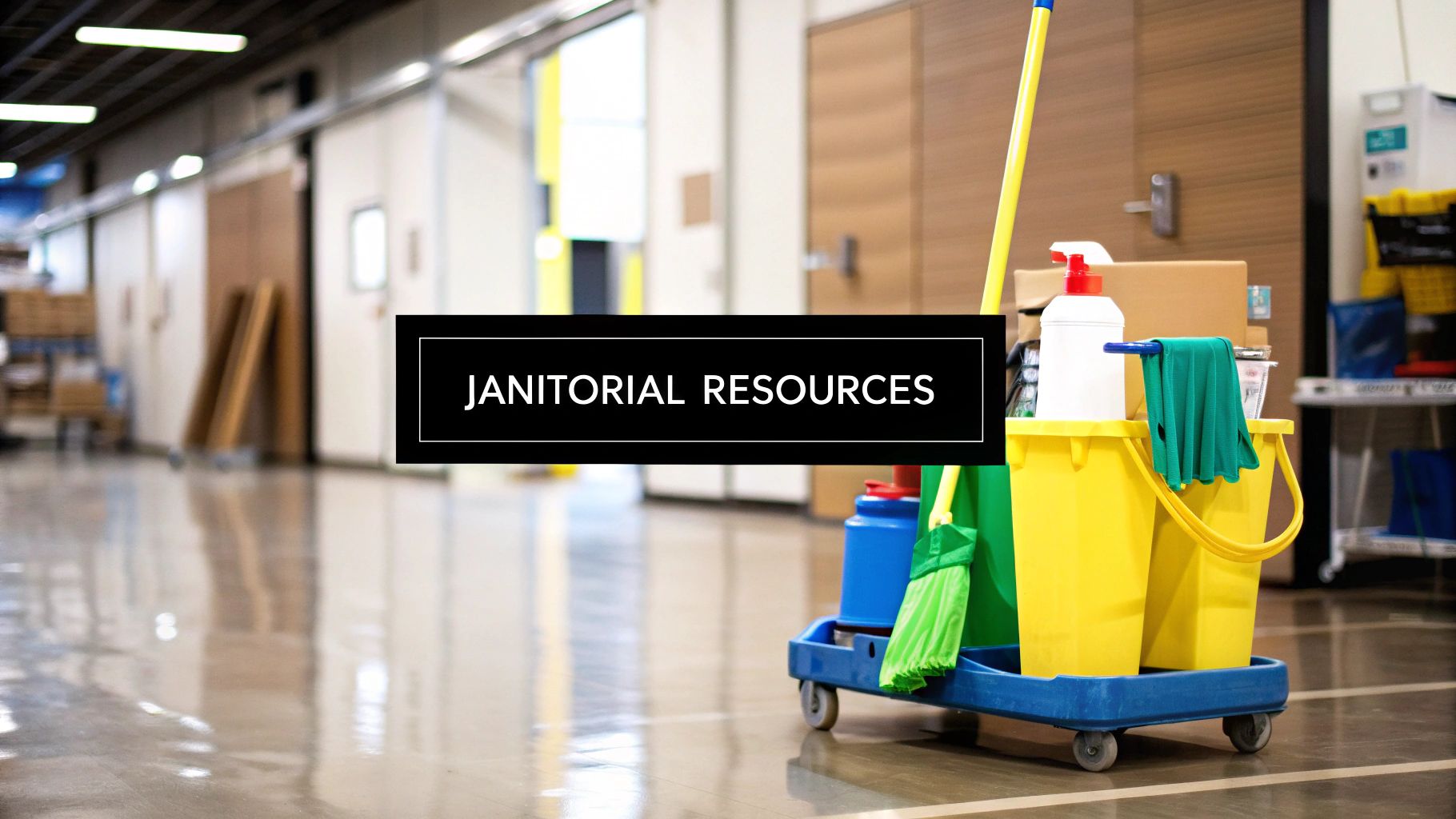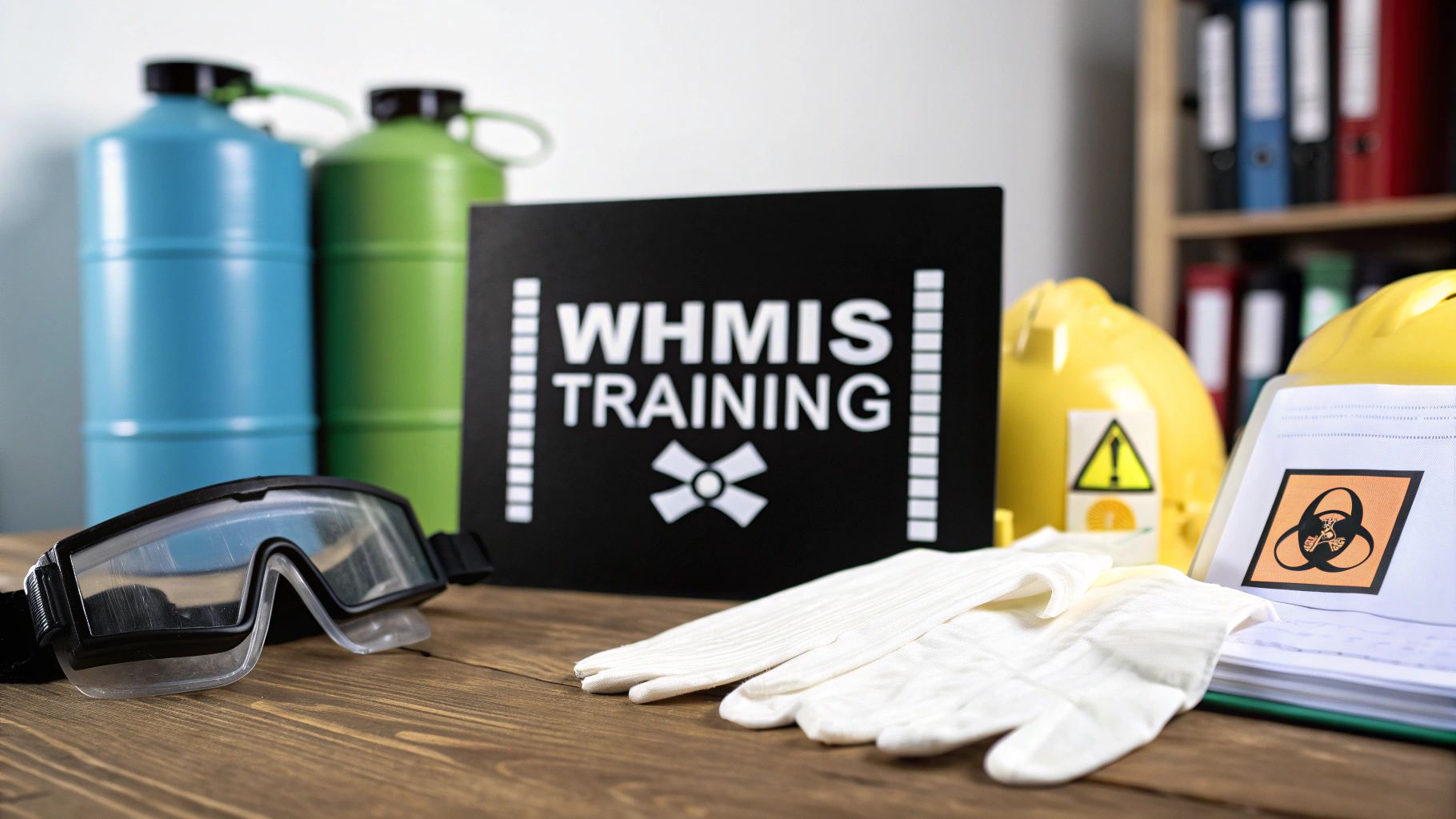Keeping your whiteboard clean is simpler than you might think. For a quick, end-of-day wipe-down, all you really need is a dry microfiber cloth or a classic felt eraser. But when you're dealing with stubborn marks or need a deeper clean, a dedicated whiteboard cleaner or a bit of isopropyl alcohol on a soft cloth will do the trick.
Your Quick Guide to a Spotless Whiteboard
A pristine whiteboard is more than just a clean surface; it’s a tool for clear communication, whether you’re in a high-stakes boardroom at a law firm or a creative studio in a tech company. A board covered in smudges and "ghosting" from old notes is distracting and frankly, unprofessional. When you invest in professional office cleaning, you expect every detail, including the whiteboard, to be spotless, contributing to a Clean Office & Peace of Mind.
The good news is, a simple routine is all it takes to keep your whiteboard looking brand new for years. Consistent maintenance is the secret—it stops the ink from seeping deep into the board's pores, which is what causes those stubborn stains in the first place.
This guide gives you straightforward solutions for every situation. We'll cover everything from the daily wipe-down to the more intensive weekly clean that brings back that original, glossy finish.
Daily, Weekly, and Stain Removal Routines
Knowing when to use a certain cleaning method is just as important as knowing how. A quick dry erase at the end of the day is your best preventative measure. A weekly wet clean, on the other hand, gets rid of the built-up residue and oils that a dry cloth can't handle. And for those inevitable moments—like when someone accidentally uses a permanent marker—you'll need a more targeted approach.
This infographic breaks down the key cleaning tasks based on how often you should do them.
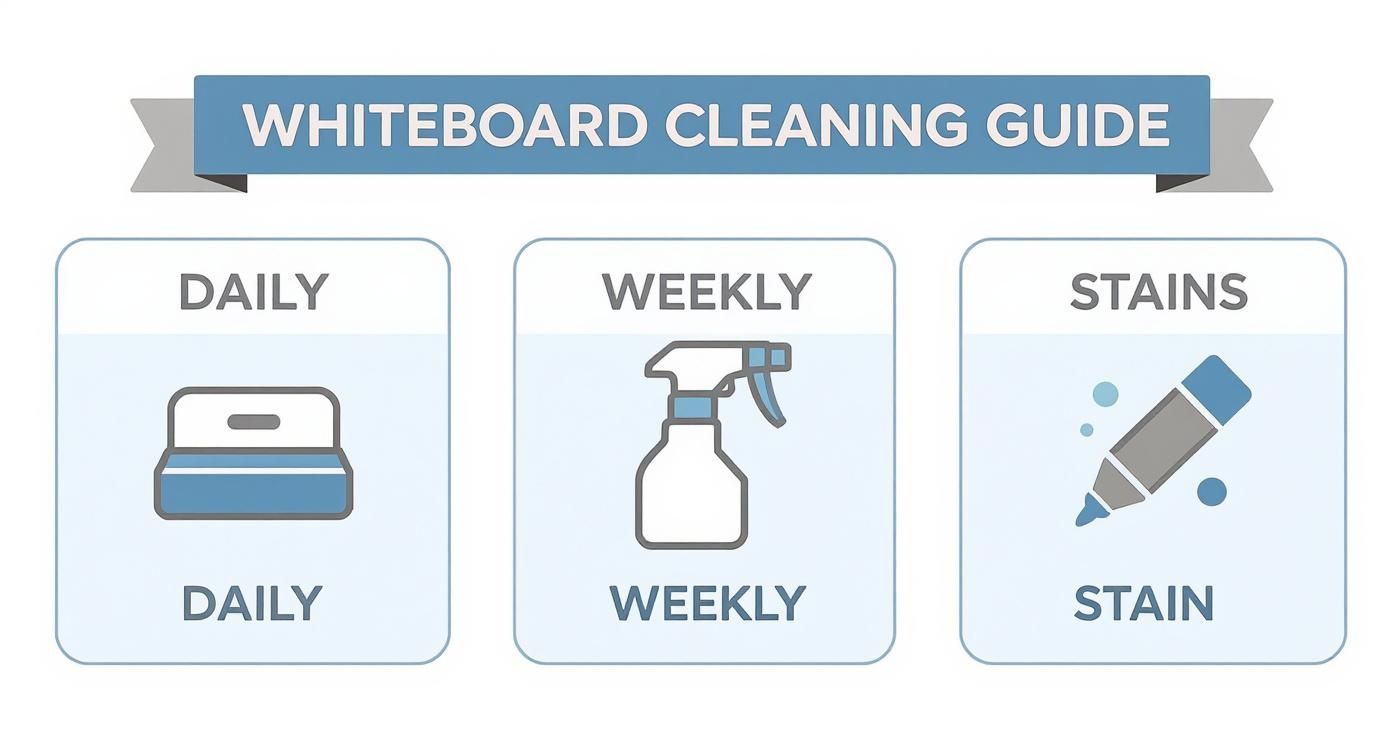
Think of it as a cheat sheet for using the right tool for the job. You’ll never have to worry about accidentally damaging your board’s surface with the wrong chemical again. The principles here are similar to those used in achieving a streak-free shine on various surfaces, where the right technique makes all the difference.
Whiteboard Cleaning at a Glance
For a more detailed look, this table breaks down the best practices for keeping your whiteboard in top shape, comparing the different cleaning frequencies side-by-side.
| Cleaning Frequency | Recommended Tools | Best Practice | What to Avoid |
|---|
| Daily | Microfiber cloth or felt eraser | Erase notes at the end of each day before the ink has a chance to set. | Using your hands (this transfers oils), wet cloths, or abrasive paper towels. |
| Weekly | Whiteboard cleaner, microfiber cloths | Spray the cleaner onto the cloth, not directly onto the board, to prevent buildup in the frame. | Household cleaners like Windex or soap, which can strip the board's protective coating. |
| Stain Removal | 90-99% Isopropyl alcohol, dry-erase marker | To remove permanent marker, draw over it with a dry-erase marker and wipe it off immediately. | Abrasive pads or scouring powders that will permanently scratch the surface. |
Following these simple guidelines ensures your whiteboard remains a reliable and professional-looking tool for collaboration. A little bit of consistent care goes a long way.
Gathering the Right Tools for the Job
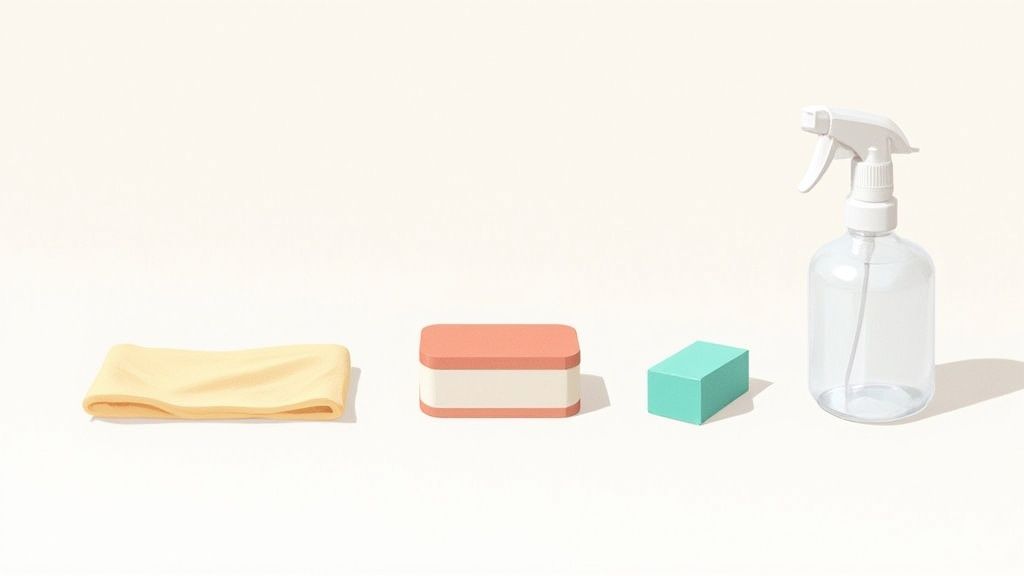
Using the wrong cleaning supplies on a whiteboard is the fastest way to permanently ruin its surface. The board's protective coating is more delicate than you think, and one wrong move—like grabbing a paper towel or a generic all-purpose cleaner—can lead to irreversible ghosting and scratches. The same principle applies to your entire facility; using the right products is a cornerstone of professional commercial cleaning.
Your first and best line of defence is always a high-quality microfiber cloth. Paper towels break down, leave lint everywhere, and can actually scratch the board. A good microfiber cloth, on the other hand, traps and lifts ink residue clean off without damaging the finish. It’s the undisputed champion for both quick dry wiping and deeper cleaning.
Erasers and Cleaning Solutions
That standard felt eraser that came with your board is fine for wiping away fresh marks, but it has a major flaw. Over time, it gets saturated with old ink and starts smudging those old marks right back onto the board. A microfiber eraser is a much smarter long-term choice because you can often wash it, giving you a fresh, clean tool every time.
When it’s time for a liquid cleaner, the safest bet is always a solution made specifically for whiteboards. Harsh chemicals are the enemy of your board's longevity.
Using abrasive cleaners like scouring powders or harsh chemicals like bleach will literally strip away the board's protective clear coat. This damage is permanent. It creates a porous surface that absorbs ink, making stains and ghosting inevitable.
For businesses that want to get it right from the start, sourcing professional-grade cleaning supplies for your office is a smart investment in protecting your equipment.
Ultimately, choosing the right tools is a simple preventative step. Avoiding a scouring pad or a wax-based cleaner prevents a costly replacement down the road and keeps your board ready for clear, effective communication.
Mastering Daily and Weekly Whiteboard Cleaning
A pristine whiteboard isn't the result of some marathon cleaning session every few months. It comes down to simple, consistent habits. Building a quick daily and weekly routine is the best way to stop ink from building up and prevent that frustrating ghosting that makes a board look tired and worn. This consistent care is a hallmark of professional office cleaning, which ensures a consistently clean workspace.
These tasks are easy to tack onto any end-of-day office shutdown.
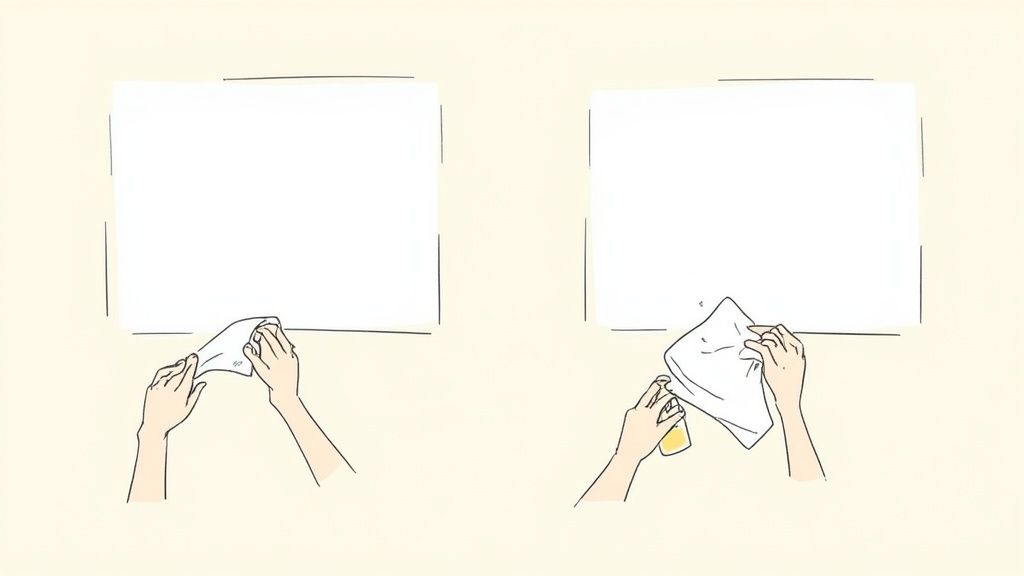
The single most important habit? The daily wipe-down. Seriously. At the end of each day, just take a few seconds to erase everything with a clean, dry microfiber cloth or a proper eraser. This simple move stops the dry-erase ink from fully curing and seeping into the board's tiny pores, which is exactly what causes stubborn stains.
The Weekly Deep Clean Method
Once a week, your whiteboard needs a bit more attention to tackle any leftover residue, oils from fingerprints, and marks that didn't quite come off. Your best tool for this is a manufacturer-approved whiteboard cleaning spray.
Here’s a crucial pro-tip: spray the cleaner directly onto your microfiber cloth, never onto the whiteboard itself. When you spray the board, the liquid can drip down and pool along the bottom of the frame. Over time, this can damage the frame or even seep behind the board. Wiping with a dampened cloth gives you total control and ensures a perfectly even clean.
After you've wiped the board down with the cleaning solution, do one final pass with a separate, completely dry microfiber cloth. This step is key—it buffs away any leftover cleaner residue, making sure the surface is totally dry and ready for your next brainstorming session without any smearing.
A Clean Board for a Healthy Workspace
Keeping your whiteboard clean is about more than just looks; it's a small but important part of maintaining a healthier work environment. Think about it—a whiteboard is a high-touch surface, constantly used during meetings and team huddles, whether in a dental office waiting room or a manufacturing plant's briefing area. Regular cleaning helps cut down on the spread of germs, a fundamental principle in professional commercial cleaning.
Guidelines for maintaining clean surfaces in busy places like schools and offices always call out high-traffic items. You can read more about these health-focused cleaning standards. This is the same level of detail that’s central to professional office cleaning services, which focus on every part of your workspace to keep it healthy and safe.
How to Tackle Stubborn Stains and Ghosting
Even with a solid cleaning routine, you'll eventually run into two of the most common whiteboard frustrations: accidental permanent marker stains and that faint "ghosting" of old notes. Both can make a board look tired and unprofessional, but you can usually fix them without damaging the surface if you know the right tricks.
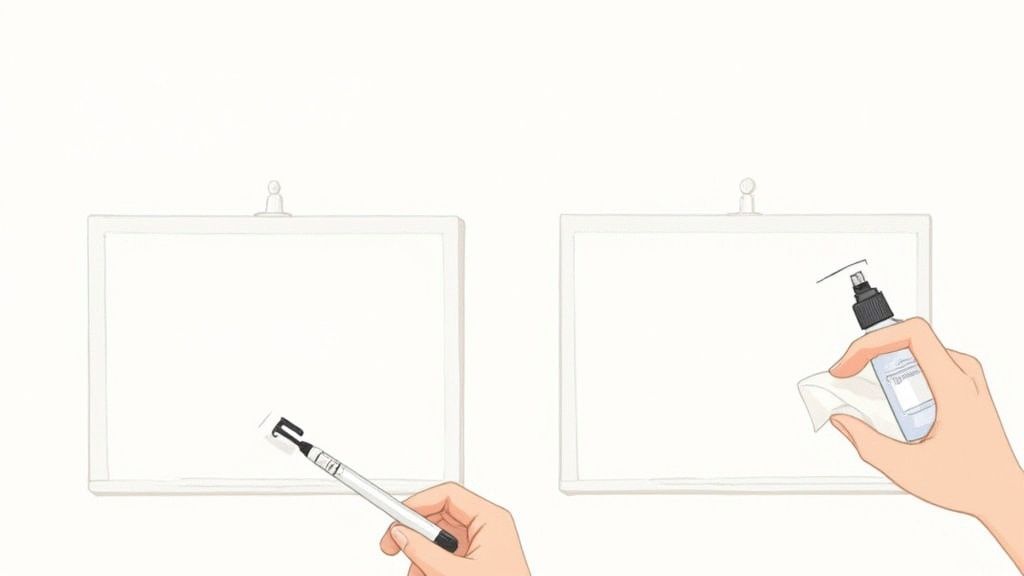
Before you reach for a harsh chemical, try this for permanent marker. It sounds weird, but it works surprisingly well. Just take a high-quality dry-erase marker and draw directly over the permanent ink. Let it sit for a few seconds, then wipe it all away with a clean microfibre cloth.
Why does this work? The solvent in the dry-erase ink is just strong enough to dissolve the permanent ink, lifting it right off the board's surface. It’s a simple, effective fix that has saved many whiteboards from an early retirement.
Safely Removing Ghosting with Isopropyl Alcohol
Ghosting is that shadowy residue left behind from old writing, and it’s a clear sign that a deeper clean is in order. It happens when ink pigment gets trapped in the microscopic pores of the whiteboard surface. For professional cleaners, the go-to solution is 90-99% isopropyl alcohol.
Here’s how to use it safely for a deep clean:
- Test a small spot first. Before you go all-in, dab a small amount of alcohol on a microfibre cloth and test it in a discreet corner. This quick check ensures it won’t react badly with your board’s particular finish.
- Apply and wipe gently. Lightly dampen a clean microfibre cloth with the alcohol. Using a gentle circular motion, wipe the ghosted areas. You should see the faint ink start to lift almost immediately.
- "Rinse" the surface. This step is critical. After cleaning with alcohol, you need to remove any residue. Wipe the entire board with a separate cloth that’s been lightly dampened with plain water. Leftover alcohol can make it harder for new marker ink to stick properly.
- Dry it thoroughly. Finally, take another clean, dry microfibre cloth and buff the entire surface until it's completely dry. This prevents streaks and leaves the board perfectly prepped for your next brainstorming session.
These kinds of cleaning challenges often point to bigger issues in facility maintenance. A comprehensive audit of California schools, for example, found many struggled with interior cleanliness because their resources were stretched thin. The guidelines recommend one custodian for every 19,000–25,000 square feet, but many staff were responsible for much larger areas, leading to tasks like proper whiteboard cleaning getting overlooked. You can read the full report on school maintenance standards to see just how much staffing can impact overall facility upkeep.
Long-Term Whiteboard Care and Prevention
The secret to making your whiteboard last for years isn’t some complicated trick—it’s just proactive care. A little bit of consistent maintenance goes a long way, extending its life and saving you the headache and cost of a premature replacement. This proactive approach is a core value of professional commercial cleaning services.
Over time, a whiteboard's surface can develop microscopic pores that trap old ink, leading to that stubborn ghosting that never seems to fully disappear.
A simple preventative strategy is to recondition the surface every so often. You can do this with a specialized whiteboard polish or conditioner. This quick process fills in those tiny pores and restores the board's original smooth, non-porous finish, making every wipe feel like new again.
Choosing Healthier Supplies for Your Office
The supplies you choose have a bigger impact on your workspace than you might think. For instance, opting for low-odour dry-erase markers is a small change that can significantly improve the indoor air quality in stuffy meeting rooms and classrooms.
This simple switch aligns with the broader trend toward using healthier, green cleaning products in shared spaces, a standard upheld by leading organizations like ISSA. It’s a win-win. Schools that have made the move to certified green cleaning products often see savings by using concentrated cleaners, an approach that also minimizes respiratory risks for everyone in the building. It’s worth looking into the health benefits of green cleaning practices to see how these small choices impact the bigger picture.
By adopting these simple habits—like regular conditioning and choosing better markers—you can ensure your whiteboard remains a dependable communication tool. Prevention is always the best cure for keeping your workspace clean and professional.
For more insights on maintaining a pristine workspace, check out our guide on keeping the office clean as Ontario reopens.
Your Whiteboard Cleaning Questions Answered
Even with a solid routine, questions about keeping a whiteboard in top shape always pop up. Let's tackle some of the most common ones I hear from clients, so you can troubleshoot any issues and keep your board looking brand new.
Why Is Professional Office Cleaning Important for My Facility?
Beyond just a clean whiteboard, professional office cleaning ensures a healthy, productive, and welcoming environment for employees and clients. Whether it's a medical office cleaning service focusing on sanitization, or a team maintaining a large commercial facility like a warehouse or insurance office, experts bring the right tools and knowledge. A professional service addresses high-touch surfaces, air quality, and overall hygiene, which directly impacts staff well-being and reduces sick days. Consistent, high-quality cleaning creates a Clean Workspace & Peace of Mind.
Can I Use Household Cleaners Like Windex?
It's tempting to grab whatever is under the sink, but please, step away from the Windex. All-purpose cleaners and even soap and water are a whiteboard’s worst enemy.
The chemicals in these products are too harsh and will gradually strip away the board's protective coating. Once that's gone, you're left with permanent ghosting and a surface that’s nearly impossible to erase. Your best bet is always a cleaner made specifically for whiteboards or, for really stubborn marks, 90-99% isopropyl alcohol.
What Is the Best Way to Remove Permanent Marker?
I know the panic that sets in when someone accidentally uses a Sharpie. Luckily, there's a surprisingly simple trick for this.
Just take a high-quality dry-erase marker and draw directly over the permanent ink. The solvent in the dry-erase marker actually helps dissolve the permanent stuff. Let it sit for a moment, then wipe it all away with a clean microfibre cloth. You might need to do it twice, but it works like magic almost every time.
Where Can I Find Professional Office Cleaning Near Me?
Finding reliable commercial cleaning near you is crucial for maintaining your business's standards. Arelli Cleaning offers award-winning services with local teams ready to serve you. We have office cleaners near every major location, including Toronto, Mississauga, Vaughan, Richmond Hill, and North York. You can see a full list on our service areas page.
What Makes Arelli Different from Other Cleaning Companies?
Arelli provides more than just a clean office; we deliver peace of mind. Our award-winning service, recognized for the third consecutive year by the Consumer Choice Award, is built on trust and customer satisfaction.
We stand out with our Price Match Guarantee, no cancellation or change fees, and premium customer service available on-site, by phone, or through our dedicated app. Plus, we offer a free 45-minute sample clean of a dedicated area with every quote, so you can see our quality firsthand. For more answers, explore our comprehensive FAQ page.











